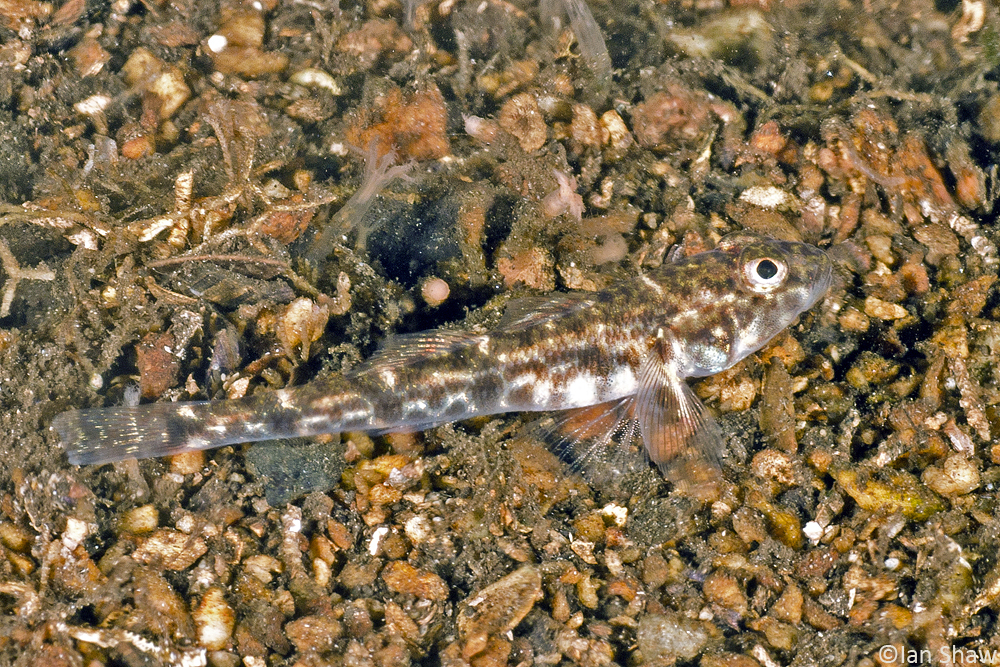Hinsby's Goby, Nesogobius hinsbyi (McCulloch & Ogilby 1919)
Other Names: Girdled Goby, Orangespotted Goby, Orange-spotted Goby, Orange-spotted Sand-goby, Tasmanian Orange-spotted Sand Goby

Hinsby's Goby, Nesogobius hinsbyi, at Little Woody Island, Bathurst Channel, Port Davey, Tasmania. Source: Ian V. Shaw. License: CC BY Attribution
Summary:
A sandy to orange-brown goby becoming pale below, with four to six large brown spots along the midside, often with smaller spots between the large spots, narrow brown bars extending above and below the spots, a long brown wedge-shaped bar on the caudal peduncle, and a dark spot at the upper part of the pectoral-fin base.
Cite this page as:
Bray, D.J. 2019, Nesogobius hinsbyi in Fishes of Australia, accessed 27 Jun 2025, https://fishesofaustralia.net.au/Home/species/3068
Hinsby's Goby, Nesogobius hinsbyi (McCulloch & Ogilby 1919)
More Info
|
Distribution |
Endemic to southern Australia from Port Phillip, Victoria, to Decres Bay, South Australia, and around coastal Tasmania. The species is reportedly abundant in southern Tasmanian estuaries, but relatively uncommon elsewhere. Inhabits sand and rubble substrates in coastal waters and tide pools at depths to 60 metres, usually greater than 20 m. |
|
Features |
Dorsal fin VIII-IX + I, 9-10; Anal fin I, 10-11; Caudal fin (segmented rays) 13, (branched rays) 9; Pectoral fin 17-20; Pelvic fin I, 5; Gill rakers 0-1 + 6-9 = 6-9. Body slender, head broader than deep, eyes almost touching; head pores absent; top of head scaled to behind eyes; two dorsal fins, first dorsal low with rounded margin, tall in males; gill openings broad. |
|
Etymology |
The species is named in honour of Mr. George Hinsby, who contributed many natural history novelties to the Tasmanian Museum. |
|
Species Citation |
Gobius hinsbyi McCulloch & Ogilby 1919, Rec. Aust. Mus. 12(10): 215, pl. 33(1). Type locality: Wedge Bay, Hobart, Tasmania, 5-10 fathoms. |
|
Author |
Bray, D.J. 2019 |
|
Resources |
Hinsby's Goby, Nesogobius hinsbyi (McCulloch & Ogilby 1919)
References
Castelnau, F.L. de 1872. Contribution to the ichthyology of Australia. 1. The Melbourne fish market. Proceedings of the Zoological and Acclimatisation Society of Victoria 1: 29-242 1 pl. (p.124, described as Gobius pictus, a junior homonym of Gobius pictus Malm, 1865).
Edgar, G.J. 2000. Australian Marine Life: the plants and animals of temperate waters. Sydney : Reed New Holland Revised Edn, 544 pp.
Edgar, G.J. 2008. Australian Marine Life: the plants and animals of temperate waters. Sydney : Reed New Holland 2nd edn, 624 pp.
Hammer, M.P., Hoese, D.F. & Bertozzi, T. 2015. A new species of near-shore marine goby (Pisces: Gobiidae: Nesogobius) from Kangaroo Island, Australia. Zootaxa 4057(3): 371-384. http://dx.doi.org/10.11646/zootaxa.4057.3.4
Hoese, D.F. & Larson, H.K. 1994. Family Gobiidae. pp. 781-810, figs 690-714 in Gomon, M.F., Glover, C.J.M. & Kuiter, R.H. (eds). The Fishes of Australia's South Coast. Adelaide : State Printer 992 pp. 810 figs.
Hoese, D.F. & Larson, H.K. 2006. Description of two new species of Nesogobius (Pisces: Gobioidei: Gobiidae) from southern Australia. Memoirs of Museum Victoria 63(1): 7-13.
Hoese, D.F. & Larson, H.K. 2008. Family Gobiidae. pp. 749-773 in Gomon, M.F., Bray, D.J. & Kuiter, R.H. (eds). Fishes of Australia's Southern Coast. Sydney : Reed New Holland 928 pp.
Kuiter, R.H. 1993. Coastal fishes of south-eastern Australia. Crawford House Press Pty Ltd., Australia.




